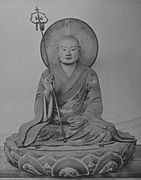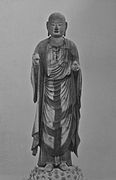Kaikei
Kaikei ( Japanese 快 慶 ) was a major Japanese sculptor in the late 12th and early 13th centuries.
life and work
Kaikei was a student and adopted son of Kōkeis and, along with his brother Unkei, played a major role in the development of the style of the Kamakura period . He came under the influence of the Shunjōbō Chōgen ( 俊 乗 房 重 源 ; 1121-1206), a monk of the Jōdo-shū who took care of the reconstruction of the Tōdai-ji . Kaikei then became an avid believer and adopted the religious name Annamidabutsu ( 安阿 弥陀 仏 ). His sculptures, which are characterized by graceful design and perfect proportions, established the so-called Annami style, and Kaikei itself was called "Annami".
Kaikei's earliest existing work is the Maitreya in the Boston Museum of Fine Arts from 1189. During the restoration of the Tōdai-ji, he worked with Jōkaku on the sculptures at the Nyoirin Kannon ( 如意輪 観 音 ) and on the base for the great Buddha. Kaikei also made the Kōmoku-ten ( 広 目 天 ), one of the four heavenly kings ( 四 天王 , Shitennō ). Although Kaikei was involved in these projects as a member of the Kōkei's studio, his close ties with Chōgen led him to the 1201 creating the sculpture of the monk Sōgyō Hachimanshin ( 僧 形 八 幡 神 ) in the Tōdai-ji Chinju Hachiman-gū ( 鎮守 八 幡 宮 ) and a few years later also participated in the production of the holy Jizō ( 地 蔵 菩薩 , ~ -bosatsu ) in the Kōkei Hall ( 公 慶 堂 , Kōkei-dō ). All of these figures still exist. - Kaikei was also active in projects of the Chōgen that were not intended for the Tōdai-ji. These include the still existing Amida trinity, which he created in 1197 for the Jōdo-ji in Hyōgo prefecture and in 1201 the main character (of which only the head still exists) for the Shindaibutsu-ji ( 新 大 仏 寺 ) in Mie prefecture . The figures in these temples were modeled after Amida figures on paintings from the Song era , for which Chōgen showed a particular fondness. - Kaikei also made sculptures for representatives of the Jōdo direction, such as Kūamidabutsu Myōhen ( 空 阿 弥陀 仏 明 遍 ; 1142–1224), Gedatsubō Jōkei ( 解脱 坊 貞 慶 ; 1155–1213) and Kōben Myōe ( 高 弁 明 恵 ; 1173– 1232) as well as for court aristocrats. - A major project of this early period was the restoration of the eleven-faced Kannon des Hase-dera in Nara Prefecture .
Almost all of Kaikei's existing works are signed. And since the signature changes over the years, it is possible to give an approximate date of the work even though there is no written evidence. This in turn makes it possible to show the development of his style. First he signed as Busshi Kaikei ( 仏 師 快 慶 ), so as "Master of the Buddhist Art Kaikei", then from 1192 to 1203 as "Annamidabutsu". In 1203 he received the honorary title Hokkyō and now signed as "Hokkyō". After 1210 he appears as "Hōgen" Kaikei, after he was promoted further that year.
In his early work, Kaikei shows a realism very similar to that of Kōkei and Unkei. But over time he developed his own personal style. The statues of the god Hachiman as a monk and the Amida Nyorai in the Shunjō Hall ( 俊 乗 堂 , Shunjō-dō ), both sculptures are in the Tōdai-ji, show his matured style with a balance of grace and realism. In the later years his style took on a slightly formal note.
Kaikei's style was adopted by his students Gyōkai, Chōkai ( 長 快 ), and Eikai ( 栄 快 ), and the influence of his style can also be felt in later centuries. Eikai, who also received the title Hokkyō, created the Jizō in Chōmei-ji in Shiga Prefecture . The portrait statue of Kōbō Daishi in Rokuharamitsu-ji comes from Chōkai .
photos
Individual evidence
- ^ Metropolitan Museum (New York)
- ↑ a b Hokkyō ( 法眼 ) and the higher level Hōgen ( 法眼 ) are two honorary titles that were originally awarded to priests, but later also to artists and scholars.
- ↑ In the Freer Gallery of Art .
literature
- Tazawa, Yutaka: Kaikei . In: Biographical Dictionary of Japanese Art. Kodansha International, 1981. ISBN 0-87011-488-3 .
- Laurance P. Roberts: Kaikei . In: A Dictionary of Japanese Artists. Weatherhill, 1976. ISBN 0-8348-0113-2 .
| personal data | |
|---|---|
| SURNAME | Kaikei |
| ALTERNATIVE NAMES | 快 慶 (Japanese) |
| BRIEF DESCRIPTION | Japanese sculptor |
| DATE OF BIRTH | 12th Century |
| DATE OF DEATH | 13th Century |






